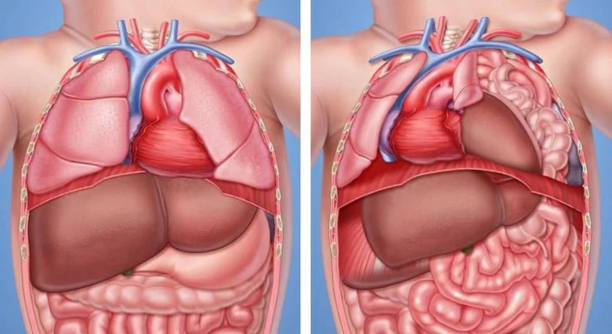If your baby has been diagnosed with or shows symptoms of Congenital Diaphragmatic Hernia, contact us immediately for expert surgical care and neonatal support in Ghaziabad. Early and specialized treatment significantly improves outcomes and quality of life.
Congenital Diaphragmatic Hernia
Home »Congenital Diaphragmatic Hernia
What is Congenital Diaphragmatic Hernia?
Congenital Diaphragmatic Hernia (CDH) is a condition where the diaphragm (the muscle separating the chest from the abdomen) has a hole, allowing abdominal organs such as the intestines, liver, or stomach to move into the chest cavity. This displaces the lungs and affects their growth, leading to underdeveloped lungs (pulmonary hypoplasia) and breathing difficulties at birth.

Symptoms of CDH
CDH is often diagnosed before birth during a routine prenatal ultrasound. In newborns, symptoms are immediate and may include:
Severe difficulty in breathing
Bluish skin (cyanosis)
Sunken abdomen
Asymmetrical or underdeveloped chest
Rapid heartbeat and breathing
These symptoms are a medical emergency and require immediate intervention.
Diagnosis and Treatment in Ghaziabad
Prenatal diagnosis through ultrasound or fetal MRI allows for early planning of delivery in a specialized center. After birth, diagnosis is confirmed using:
Chest X-ray
Echocardiography
Blood gas analysis to evaluate lung function
Treatment includes:
Stabilization in a Neonatal Intensive Care Unit (NICU) with ventilator support
Surgical repair once the baby is stable — the abdominal organs are moved back into the abdomen and the hole in the diaphragm is closed
Ongoing respiratory and nutritional support
Severe cases may require extracorporeal membrane oxygenation (ECMO), a form of heart-lung bypass support (available at select centers).
Why Choose Us?
Highly experienced pediatric and neonatal surgical team
Advanced NICU with 24/7 monitoring
Individualized care plans for each baby
Trusted center in Ghaziabad for complex neonatal conditions

